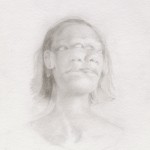Michael Nichols at the Carnegie
by Kevin Muente
Michael Nichols’s silently disturbing silverpoint drawings are tucked away in the small hallway gallery at the Carnegie. If you aren’t familiar with the medium of silverpoint, the end result resembles graphite drawings to an extent and to an untrained eye could perhaps pass as such. The medium differs from graphite in that the surface must be prepared using a zinc white watercolor wash. The artist uses a stylus usually made of silver but sometimes other metals like copper, lead, gold, or tin, to deposit marks or lines on the surface. The lines of silverpoint can’t be erased and are softer than graphite. Lastly, the metal deposits on the surface will eventually tarnish. When first made, silverpoint lines appear bluish gray, but after time they take on a brownish patina.
The ten drawings in this show are all matted in white with maple stained frames. All of the drawings contain figures with views from the chest or neck up surrounded by the vacant white space of the paper. We have no spatial context in which our subjects reside, and Nichols uses a limited value range without much contrast. It’s hard to delineate his models’ features, and when we do, we often notice that they may have two noses or four eyes.
The artist states that he uses multiple or co-existing vantage points to dissolve contours to create less certainty. Upon first glance we may look directly into the eyes of a female sitter only to notice after closer inspection that she has a second pair of eyes. Her expression is hard to read as well, since she has two bottom lips which tremor to a frown. The piece just described is entitled Remnant and makes me wonder if the movement from the lips is all that remains from words forever lost.
Silverpoint, which can’t be erased, showcases strong draftsmanship, and these drawings do have a confidence, but I’m unsure if this is the best medium for Nichols to use. A medium like charcoal would show erasure marks, which could help to enhance the temporal shifts in his subjects. However, some of the drawings do depict a state of flux in multiple ways. In the drawing Echo a female figure looks off to her right. The drawing has a sense of movement in that we see four eyes, two noses, and two sets of lips. She is forever trying to catch something seen from the corner of her eye. Nichols superimposes a sense of time with the multiple features traveling through a short distance almost as if the figure is caught manifesting itself from the ether of the blank page. The lines have also changed. When this drawing was created the lines appeared a cold blue, but they now have a warm brownish glow which occurs over time as the silver tarnishes.
Other drawings leave the viewer guessing at the identity of the subjects. In both Influx and Absorb, Nichols obscures the faces by leaving a pristine circle the color of the paper over the female sitter. In Influx, the circle has been replaced by a bold square with similar characteristics of purity. These two drawings in particular force an ironic and frustrating viewing dilemma. Unable to see the particular facial features due to their masking by the circle or the square I found myself examining the minimal pristine whiteness of the page inside these basic shapes. Nichols essentially wipes out the identity of these sitters, with no recognizable characteristics and not much else to go on. I felt robbed of his draftsmanship apparent in so many of his other works.
Nichols’ drawings remind me of the 1990 film Jacob’s Ladder staring Tim Robbins, in which the main character, Jacob Singer, at first suffers from schisms in reality and later must confront nightmarish and bizarre hallucinations. The ten drawings in this show are elusive and if casually passing through the small gallery a viewer might miss the nuanced misplacing of features in these portraits. When caught these shifting features are disorienting and beg for a second and third read. The viewer must grapple with perception and is left in an awkward state. The drawings–both beautiful and disturbing–lack a resolution, which creates a sense of disorientation and discordance that continues to rattle in the mind’s eye long after the viewer leaves the exhibit.






